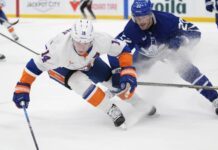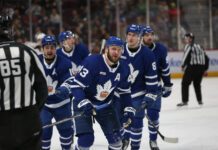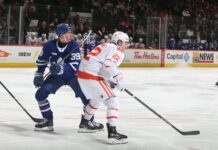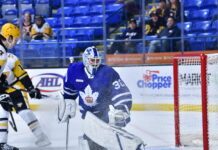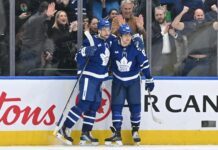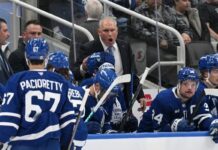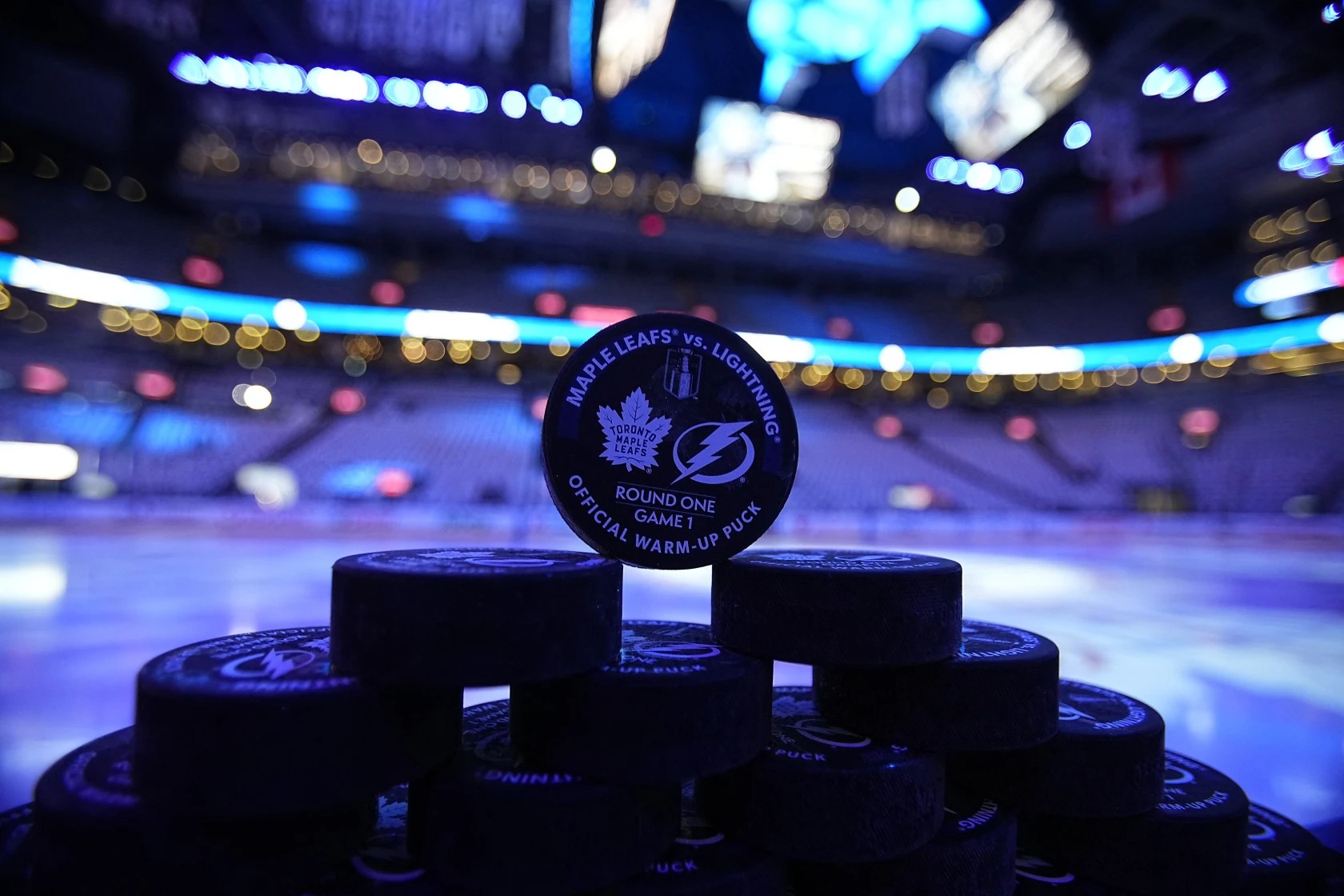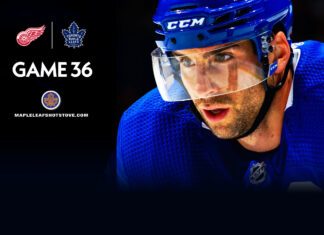Game 1 wasn’t far off of the absolute worst-case scenario for the Maple Leafs.
If there is a silver lining, it’s that the Leafs didn’t pick up any key injuries we’re aware of while Tampa Bay faces the prospect of a Game 2 without (possibly) Victor Hedman and Erik Cernák on a blue line that already faced significant question marks entering this series.
As tough as it might be for Leafs fans to stomach, it’s time to digest the turning points and notable performances from the 7-3 loss before we look ahead to the key storylines for Game 2.
Turning Points

The first turning point came early in Game 1. The Lightning started hot, the Leafs were a little tentative, and Tampa scored an early goal — not at all an ideal beginning if you’re the Leafs looking for a fast start in front of a charged-up home crowd, but it was not the end of the world. The real turning point came in the lack of response afterward.
The Leafs didn’t do much of anything to assert control after the first goal went in. There was a pass through the crease that a jiggered defense pair of Jake McCabe and Morgan Rielly were barely able to redirect wide of the net (those two committed an odd turnover under forecheck pressure from Corey Perry a little bit later as well). Toronto only created a few good shifts in the first eight or so minutes of the game, spinning their tires in the neutral zone.
The Leafs lost the territorial battle, were outdone in the neutral zone, and struggled to exit the zone cleanly. Tampa was able to enter the offensive zone like it was a walk in the park. It was a very poor opening sequence to the series, one Sheldon Keefe struggled to explain after the game.
Toronto generated their first strong shift of the night from the Matthews/Marner line shortly beforehand, but it was Marner who started the play leading to the 2-0 goal against. His linemates had changed when he grabbed a loose puck and flipped it up and out of the defensive zone before heading off for William Nylander, leaving Ryan O’Reilly and John Tavares on the ice. Marner’s flip pass only made it to center ice when it was snatched down by Mikhail Sergachev, who quickly advanced it to his forwards as they entered the zone.
Anthony Cirelli passed to Brandon Hagel, and again the Leaf defense was ceding tons of space to the Bolts. Ilya Samsonov was unable to squeeze a rather harmless shot up high, Mark Giordano failed to box out Cirelli in front, and another mad scramble in front resulted in another Lightning goal.
That first turning point gave Tampa firm possession of the game. The second came right as the game was slipping away from Tampa.
Toronto played a stronger second period after eventually falling down 3-0 in the opening frame. They controlled play early on in the second, diffused the first true odd-man rush for the Lightning, and then went on the PP. Ryan O’Reilly scored a goal, and the Leafs killed off a Lightning PP after a ~questionable~ cross-checking call on Luke Schenn. A few minutes went by, the Leafs went back on the PP, and William Nylander ripped a beautiful shot by Andrei Vailevskiy through a superb screen by John Tavares.
It was now 3-2, the building was buzzing, and with 26 minutes to play, a Leaf comeback was very much in the air. The first shift back at 5v5 was fine for the Leafs, and Jake McCabe delivered a thundering check on Mikey Eyssimont that sent Scotiabank Arena into a frenzy.
That’s when refereeing shenanigans intervened. Nick Paul started hounding McCabe, demanding a fight and removing McCabe from the play (we’ll get back to that later in this piece), forcing David Kämpf to backcheck furiously on Corey Perry. Kämpf executed a completely legal stick check and knocked the puck off Perry’s stick.
For some unknown reason — especially considering that the Lightning already had been given more PPs than the Leafs (3-2 at that point) — the referee’s arm went up on what was the third consecutive extraordinarily soft call. Now the Leafs were forced to kill another penalty due to the second consecutive phantom call made within 90 seconds of a Leafs goal.
Heading to the PK in this situation was not the Leafs’ fault. Plain and simple, it was a terrible blown call in a big situation. But allowing a PPG on the ensuing kill was the Leafs’ fault, particularly TJ Brodie’s.
With Justin Holl in the corner pressuring the puck against two Lightning players, Brodie made an extremely strange decision to apply extra pressure in the corner, finishing a check on Anthony Cirelli after Cirelli moved the puck. Brayden Point slipped out from the corner and made a bee-line to the net. The speedy centerman was always going to have an advantage racing to the spot against an out-of-position Brodie. Ilya Samsonov was put in a very tough spot and exposed, and Point flipped the puck by him. Momentum zapper.
Coming back in this situation was going to be mighty difficult against Andrei Vasilevskiy, but a two-goal deficit isn’t insurmountable, especially with a full period to play. At least the Leafs were going to be able to push and challenge a Lightning team that was missing Victor Hedman for the rest of the game.
The third and final turning point scuttled that push completely: Michael Bunting’s five-minute major penalty for an elbow to the head of Erik Cernák. I don’t think targeting the head was the intent of Bunting; on the replay, his eyes were looking at the puck and not toward Cernák. I fully believe that he meant to elbow him in the midsection while trying to rub the big defenseman off his line and gain a little bit of a positioning edge on the ensuing puck retrieval. Typically, such an elbow from Bunting’s height would hit the larger Cernák in the chest, but as the defender was hunched over, the elbow got him square in the noggin. Regardless of the intent, it was definitely reckless and a deserved major; the referees made the correct call this time.
Putting the Leafs on the PK for five more minutes — after having already faced four Lightning PPs in the first two periods alone — was a death knell. The Bolts were highly likely to score given that opportunity, although the goal they scored was extremely strange and also quite questionable.
Regardless, the game was out of reach by the end of the major penalty, and Bunting and the Leafs were left with some soul-searching to do after a nightmare Game 1.
Notable Performances

Let’s get the elephant in the room out really quickly: Ilya Samsonov was very bad last night.
There are plenty of things to complain about with the Leafs’ defense in front of him, but let’s not act as though he was outright shelled. This wasn’t that Habs/Leafs game from last weekend where one team was getting caved in non-stop the entire night. Expected goals models are going to underrate what the Lightning did offensively a little bit, but Natural Stat Trick recorded Samsonov at -2.55 goals saved above expected.
Even if we cut him a little more slack, that’s still spotting the opposition two goals via poor goaltending. You have zero shot to beat this opponent if this happens. The Lightning were effective in their approach of shooting for rebounds, but the one that led to the second goal needed to be squeezed by the Leafs goaltender.
I also thought Samsonov had a fighting chance to make a save on the Kucherov PPG at the end of the first and didn’t come up with it, either. There’s a scenario where a sharper Samsonov holds the Leafs in that first period and it’s only 1-0 through 20 minutes.
On the five-minute penalty kill, both goals scored were partly if not mostly on the goalie. I’m not sure that the fifth goal was even technically a goal at all, but if it did go in, it simply can’t from a goalie’s perspective. This was Frederik Andersen not squeezing the short-side post against Columbus calibre stuff.
Moreover, though the game was largely out of reach by the time the sixth goal went in, it was a rancid goal to give up — a soft squeaker right through the five-hole. Samsonov acknowledged his poor performance after the game so at least we’re on the same page. 29 shots against, six of which went in (.793), is not going to get it done.
On the (rare) positive end, I thought William Nylander gave the Leafs some positive shifts offensively last night. The analytics agree, crediting Nylander with the best on-ice xGF. He looked strong on the puck and also cashed in a beautiful PPG. We’re at the point where among the core forwards, Nylander has to be considered the best/most consistent playoff performer. His linemates Ryan O’Reilly and John Tavares connected on a perfectly executed power-play goal and were part of some positive offensive-zone shifts early in the second period, although they struggled to create enough clear-cut scoring chances at five-on-five.
Speaking of note creating enough clear-cut scoring chances at five-on-five, Mitch Marner and Auston Matthews were generating quite a bit of offensive zone time in the first two periods, but most of their shots were blocked. When Calle Järnkrok jumped up onto the line to replace Bunting, they were able to cash in a third goal off an abbreviated 3v2 rush entry, but 34/16 will need to be stronger next game. I didn’t have too many complaints from them in the defensive zone — and they graded out fine in terms of expected goals and the territorial battle — but much more is expected in terms of turning it into actual chances and goals.
The third line of Alex Kerfoot, Noel Acciari, and Jarnkrok (first two periods) put together a forgettable performance. They were not on ice for any goals against, but they gave the Maple Leafs absolutely nothing in over five minutes at five-on-five. Before sitting down to look at the numbers, my memory of that line’s contributions was completely blank. Sure enough, the data agreed: that line generated *one* unblocked shot attempt, 0.02 expected goals for(!!), and scoring chances were 4-0 Lightning in their time on the ice. Dreadful.
David Kämpf‘s fourth line with Zach Aston-Reese and Sam Lafferty took a lot of flak online — and they were directly at fault for a goal against, so it’s not totally unjustified — but at the very least they showed some life compared to the Acciari/Kerfoot line. The Kämpf line lost its minutes in expected goals, but scoring and high-danger chances were even and shot attempts were in the Leafs’ favor. Aston-Reese’s turnover leading to the first goal was very poor and the general approach to defense from everyone on the ice after the turnover was woeful. At this point in time, I would support breaking up/re-configuring the third line ahead of this unit.
Of course, there is the Michael Bunting situation affecting those lineup decisions. As of this writing, no suspension has been announced, but we have to assume one is coming.
I don’t know how much of a loss this really is for the Leafs right now. Bunting is currently not a particularly effective NHL player. Over his final 22 games before the playoffs, Bunting scored four goals and three assists for seven points. His game was flailing, figuratively and (at times) literally. He’s looked lost out there, and then he took a terrible penalty, one we labeled as a devastating turning point earlier.
Perhaps some time serving a suspension can screw his head put back on straight, but it does feel like we may be reaching a tipping point with Bunting. The Matthews/Marner line looked far more effective with Järnkrok on it, and even if Bunting is somehow not suspended, that looks like the top line Keefe should roll with.
As for the defense, it was a night to forget for Mark Giordano and Justin Holl. Holl was getting the lion’s share of the blame — he’s everyone’s favorite whipping boy, and don’t get me wrong, he was brutal on the first goal — but Giordano was just as bad. Giordano failed to box out in front of the net repeatedly on each of the first two goals, creating the opportunities for Tampa to collect the rebound goals.
As for Holl, he cannot whiff on Perry curling around the net on the first goal, and he and Morgan Rielly were caught sleeping on the stretch pass by Nick Perbix to Ross Colton for the breakaway seventh Tampa goal.
Jake McCabe took the first penalty of the game, and TJ Brodie made the fatal error on the decisive fourth goal. Everyone was a culprit to some degree in this game, but I think McCabe and Brodie were relatively innocent at even strength.
There wasn’t too much to note about Luke Schenn‘s game other than the softer-than-silk cross-checking call in which Schenn didn’t actually have two hands on his stick.
That leads me to the officials, which I take no satisfaction in reporting on. Refereeing is an extremely difficult job, and I have respect for anyone who tries to do it. Having attempted to umpire youth baseball one summer, I can speak from experience in saying officiating any sport at any level is not easy. I’m not someone who criticizes referees often, which is why it should carry some weight when I say that last night’s game was one of the most poorly refereed NHL games I’ve seen in a long time.
The holding call on Brodie was pretty soft, but at that point, it was the second penalty of the game. The third and fourth penalties were both mostly or completely phantom calls. Both came one or two shifts after Leafs goals when they finally created a bit of momentum.
Why the referees were rushing to hand Tampa a PP when they already had the edge in the game is beyond my comprehension. Those are the soft calls you make when you’re looking to give out a PP, typically if one team has had three or four and the other has had 0. Those aren’t calls a ref should make to the benefit of the team that already has the PP advantage, especially not when it’s a competitive hockey game in the second period.
The Leafs unloaded a clip into their own feet in the first period — no question about that. But stitching together a comeback is made far more difficult when the officiating crew is rushing to give the most deadly PP unit in the East an opportunity to strike the moment the Leafs were finally scoring and gathering momentum (twice!!).
Chris Chelios, an American with no affiliation to the Leafs (if anything, he should be anti-Leafs as an ex-Hab!), was on ESPN criticizing the refereeing crew after the second period, something Mark Messier concurred with. It does not excuse the Leafs’ performance in this game — and isn’t the sole reason they lost — but undoing their errors was made a whole lot more difficult by brutally unfavorable officiating. Ignoring this would fail to tell an honest account of the game.
There is also the matter of the immediate aftermath of the McCabe hit on Eyssimont that led to the Kämpf “slashing” penalty.
After McCabe laid out Eyssimont, Tampa’s Nick Paul began hounding McCabe, ready to drop the gloves and fight. The hit was clean. It was a good hard shoulder check right into the chest of Eyssimont. It was violent, yes, but hockey is a violent game. There was no head contact, no penalty, and the play continued.
In that situation, the player who made the hit is not required to fight the opposition player just because the opposition player is upset. NHL GMs have been talking this season about tweaks to the rule book for this situation, with the goal of discouraging fights after clean hits by handing out instigator penalties to players who initiate the fights. My hope is that had McCabe dropped the gloves, Paul would’ve been given the instigator penalty and the Leafs would’ve gone on the PP, although there are few indicators that this refereeing crew was competent enough to make the correct call.
But McCabe shouldn’t have to fight, and I think he was correct in not wanting to. He’s a very important defenseman for the Leafs; if he and Paul go to the box for five minutes apiece, Tampa wins the trade-off. McCabe is more important to Toronto than Paul is to Tampa. McCabe did nothing wrong, and he should not have to drop them.
In which case, Paul standing in front of McCabe, following him around, and impeding his ability to get back into the play should be an interference penalty. A big, hard, clean hit given by the opposition A) does not mean you are entitled to fight the player doling out the hit, and B) does not mean you can impede him from joining the play without punishment.
It’s one of my biggest pet peeves — and I’m glad that NHL leadership is showing some movement to address it — but it’s just a shame that full-scale changes weren’t in place for last night’s game. McCabe’s removal from the play put Kämpf in a tough situation on the backcheck, one he diffused perfectly only to be undermined by a wretched penalty call.
Storylines for Game 2
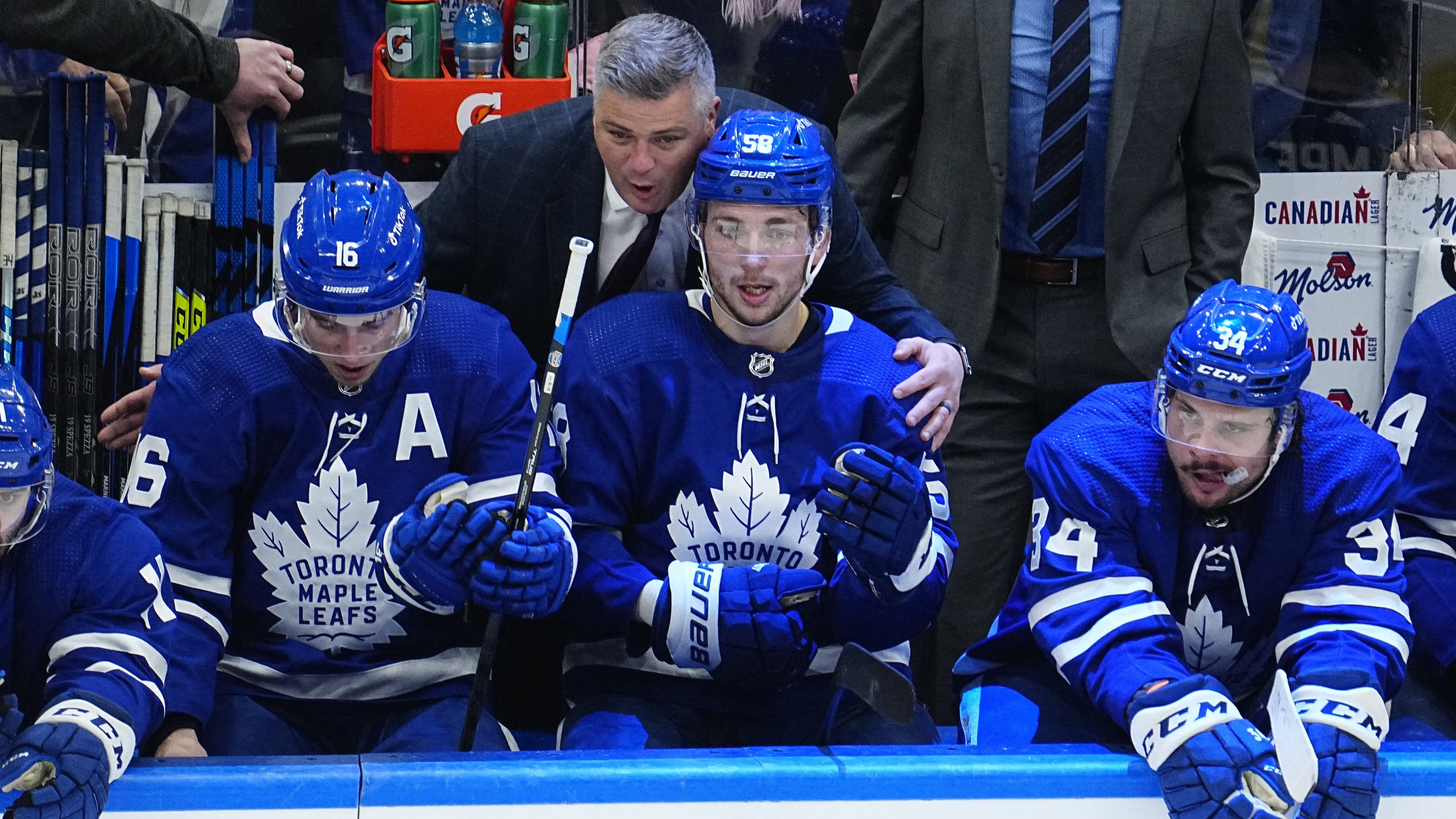
1. Starting on time. The Leafs have now played eight playoff games against the Lightning over the past two playoffs. They have not scored first in the last five games. The Lightning have gotten out to 2-0 leads in four of the last five games.
Toronto was able to claw back to tie and take the lead in two of those, but that is not a formula for success. I was a bit confused by all the talk of “this is a stunning start!!” on Twitter, because it was the exact same start that the Lightning got off to in Games 4 and 5 in last year’s series with multiple goals within the first 10 minutes of the first period.
We could also rewind to the sluggish starts against Montreal in Games 5 and 6 of 2021 if we wanted to. I don’t think anyone could be surprised if you have watched this core of Leaf players play playoff hockey over the last several seasons.
Can the Leafs get out to an early lead this time? Can they start on time? They better figure it out. A whole lot is riding on the start of the game and the first goal in Game 2. The Leafs have to come out with energy and grab the game by the horns, get out to an early lead, and assert themselves.
2. Lineup adjustments? We can assume that Michael Bunting will be out and Matthew Knies will be in. What about Timothy Liljegren? He was still dressed in a scratches uniform in practice today, but we will wait and see.
Even the Knies for Bunting swap does bring some discussion points with it. How do the lines change? I assume Järnkrok will be jumping up to the first line, but does that mean Ryan O’Reilly is down to the third-line center role? He was in practice on Wednesday, but that then leaves Nylander and Tavares together with Alexander Kerfoot, a line that has been barely treading water in goals at 5v5 for three of the past four seasons. Going back to it in a playoff game would be one hell of a gamble from Sheldon Keefe.
3. Ilya Samsonov rebounding. Sheldon Keefe provided a strange answer last night about who would start Game 2, seemingly casting doubt after yanking Samsonov for the third period of G1, but today, he re-affirmed Samsonov’s starter status. That should not be in question after one game after the regular season he had.
With Samsonov back in the net, it’s on the Russian netminder to answer the bell with a great second effort. Every goalie has bad games, and Samsonov had a handful of them this season. There were a few games around Christmas where he struggled, and there were duds against Boston in early February, Edmonton in early March, and the Islanders in late March.
What defined his season — and defines the great goalies — is the ability to turn the page and move on. Just look at Andrei Vasilevskiy last season. He was horrible in Game 1 against the Leafs with five goals allowed, including a breakaway goal for Kämpf, a Marner goal where he lost his positioning, and a misplay out of the net for the fifth goal to Matthews.
The next time out, Vasilevskiy was very sharp with .912 SV%, allowing one goal in the first 50 minutes and giving his team time to build up an insurmountable 5-1 lead. That’s the kind of response the Leafs need from Samsonov tomorrow night.
4. Penalties and special teams. The Leafs spent way too much time in the box in Game 1. Some of it was due to the unfavorable calls I mentioned, but some of it was unforced errors in Bunting’s case. Toronto needs to play a much cleaner game, keep more of the game at evens, and when they are shorthanded, kill penalties with a lot more composure than they showed in the first game.
Two PPGs allowed in the first four opportunities is not good enough to beat the Lightning. It was one of the biggest storylines entering the series, and Game 1 was a massive whiff. Part of it was the penalty killers, and part of it was the goaltending. Everyone needs to be better.
The power play was a rare bright spot for the Leafs, creating both of their goals in the second period, moving the puck around, and creating good looks. They need to keep the momentum going on the PP along with a sharper effort on the PK.
5. A must-win game. Let’s put it plainly: Game 2 is a must-win game for the Toronto Maple Leafs. Yes, teams have come back from 2-0 down in a series before to win, and they’ve done so even as the home team in the first two games (the Washington Capitals famously did it against Columbus in round one of 2018). But you’re facing the Tampa Bay Lightning here — the three-time defending Eastern Conference Champions, a team that’s also been dominant at home this season.
The series isn’t officially over if the Leafs lose tomorrow, but boy is it a steep climb back upward if they lose. The team needs to play with the fire and intensity of a team with their backs against the wall.
Compounding this is the fact that Erik Cernák, a top-four defenseman for the Lightning, will miss the game, per Jon Cooper. Victor Hedman is a game-time decision as well. The Lightning are going to be shorthanded on their defense corps and the Leafs need this game far more than the Bolts do. The Leafs will also be at home. There are no excuses.
If they can’t come away with a victory, it starts to feel like pack-it-up time on the season… and possibly this core. No pressure.








